- Join CHOICE

Travel money cards with the lowest fees
We look at seven travel money cards from the big banks and airlines..
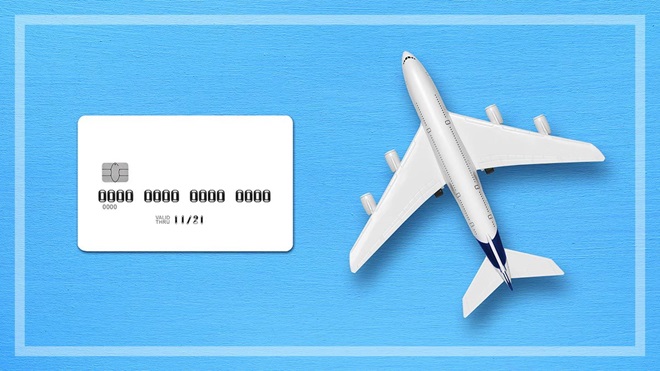
Prepaid travel money cards are offered by major banks, airlines and foreign exchange retailers like Travelex. Before travelling overseas, you load money into the card account, which locks in the exchange rate for foreign currencies at that time.
You can then use the card for purchases and cash withdrawals just like a debit or credit card, usually wherever Visa and Mastercard are accepted.
You can reload money on-the-go via an app or website, and if the card is lost or stolen, it can be replaced (usually at no cost to you).
Prepaid travel money cards also give you assurance that you're not handing the details of your everyday banking account to merchants you're not familiar with, and they provide easy access to cash when you want some, says Peter Marshall, head of research at money comparison website Mozo .
CHOICE tip: Travel money cards are best for longer trips. They're usually not worth your while if you're only taking a short trip, as some have closure, cash out and inactivity fees.
Travel money card fees
A major difference between prepaid travel cards and debit or credit cards is their fees. Some costs aren't immediately apparent, such as hefty margins built into the exchange rates.
And although fees have come down since we looked at these cards two years ago, you still need to watch out for:
- fees to load the card – either a percentage of the total or a flat fee
- ATM withdrawal fees
- a cross currency fee or margin when you use the card in a currency you haven't preloaded
- further fees if you close the account or haven't used the card for a period of time.
Travel money card with the lowest fees and best exchange rate
Westpac worldwide wallet.
Westpac closed its Global Currency Card in July 2021 and offers its new card in partnership with Mastercard. It's also available from Bank of Melbourne and BankSA.
Currencies: AUD, USD, NZD, EUR, GBP, SGD, THB, JPY, HKD, CAD, ZAR.
Key features:
- No loading, reloading, closing or inactivity fees.
- Free to use it in network ATMs in Australia and partner ATMs overseas in a range of countries including the UK, US and New Zealand.
- A charge applies at non-Westpac and non-partner ATMs in Australia and overseas.
- Best exchange rates for the US dollar, the Euro and GBP in our comparison.*
- The only card that lets you preload the South African rand.
Other travel money cards
Next to the Westpac Worldwide Wallet, there are six other travel money cards available.
Australia Post Travel Platinum Mastercard
Available online or at post offices.
Currencies : AUD, USD, NZD, EUR, GBP, SGD, THB, JPY, HKD, CAD, AED.
- Fee to reload the card via BPay, debit card or instore, but free via online bank transfer.
- Closure fee.
- Fees for ATM withdrawals in Australia and overseas.
Cash Passport Platinum Mastercard
It's issued by Heritage Bank and is available online and from a number of smaller banks and credit unions (like Bendigo Bank and Bank of Queensland) as well as travel agents.
- Fee to reload with a debit card or instore, but free via BPay.
CommBank Travel Money Card
CommBank Travel Money Card (Visa)
As NAB and ANZ have closed their travel money cards, this is the only other travel money card available from a major bank. This card has the largest variety of currencies that can be preloaded.
Currencies : AUD, USD, NZD, EUR, GBP, SGD, THB, JPY, HKD, CAD, AED, VND, CNY.
- Fee if you make a purchase with currencies not preloaded.
- Fee for withdrawals at overseas ATMs.
Qantas Travel Money Card
Qantas Travel Money Card (Mastercard)
The only travel money card offering from an airline. It can be added as a feature to your Qantas Frequent Flyer card, so you don't need a dedicated card, and you can earn points using it.
- Free to reload via bank transfer or BPay, but there's a reload fee if using debit card.
Travelex Money Card
Travelex Money Card (Mastercard)
Travelex is an international foreign exchange retailer. In Australia, it operates more than 140 stores at major airports and shopping centres, across CBDs and in the suburbs. It was the card with the best exchange rate for New Zealand dollars.*
Currencies : AUD, USD, NZD, EUR, GBP, SGD, THB, JPY, HKD, CAD.
Fees :
- Load fee instore, but free via Travelex website or app.
- Reload fee instore or via BPay, but free via Travelex website or app.
- Closure fee and monthly inactivity fee (if not used for 12 months).
Travel Money Oz Currency Pass
Travel Money Oz Currency Pass (Mastercard)
The Travel Money Group is owned by Flight Centre and is a foreign exchange retailer.
- Reloading the card via an online bank transfer or instore is free, but there's a fee if you reload via BPay, debit card or credit card.
- Cash out (closure) fee.
Travel money card tips
- Make sure the card allows the currencies you'll need, and also consider stopovers. For example, the South African rand is only supported by the Westpac card.
- Try to load your card with the right currencies and amounts on days with good exchange rates.
- Make sure you know how to reload your card if you run out of funds while overseas.
- It may be more convenient to choose a card that has an app that can be linked to your bank account.
- Avoid loading more money than you'll need as there may be fees and exchange rate margins to get the unused money back.
- Remember to cancel the card once you're finished your trip, especially if it has inactivity fees.
- Be mindful that you still may need a credit card, as travel money cards may not be accepted as security for hotels and car rental agencies.
Stock images: Getty, unless otherwise stated.
Join the conversation
To share your thoughts or ask a question, visit the CHOICE Community forum.
Travel Money Card Comparison
How to find the best card for your next overseas trip.
In this guide
Travel money card comparison
What is a travel money card, the pros and cons of different options, what are the travel money card fees i should know about, how to find the best travel money card, top travel money tips, australian travel statistics, faqs about prepaid travel money cards.
Travel Money Cards
What you need to know
- The most important features to compare are the foreign transaction fees, exchange rates and usability.
- If you want to withdraw cash, a prepaid travel card or debit card will likely be cheaper than a credit card.
- It is a good idea to have several travel money options in case of loss, damage or theft.
A travel money card is a prepaid card which you can add multiple foreign currencies onto to use while you're travelling overseas. You can use it to make purchases and withdraw cash from ATMs.
Prepaid travel cards work similarly to debit cards as you can deposit a certain amount of money into the card and only spend what you've got available in the account. However, unlike a standard debit card, a prepaid travel card allows you to lock-in exchange rates before you travel.
You can also avoid some of the fees that you might be subject to if you were to use your normal bank card. Many transaction accounts have international transaction fees or other limitations, so getting a travel money card can save you money there. It can also feel safer to have a travel money card, avoiding the risk of losing your money if something were to happen to your bank card.

Westpac Choice
There is no universal best travel money card as your options vary from country to country and person to person. In saying that, some of favourable features of travel cards include:
- No additional fees: including ATM fees, reloading fees and card closure fee
- The option to lock in exchange rates before you leave
- The option to add multiple currencies onto the one card
- Digital wallet compatibility so you can add the card to Apple Pay or Google Pay
- Low or no additional cost to convert your left-over money back to AUD
- Security, including card pin
You should also consider exchange rates, conditions, limits and safety.
Here are our top travel money tips:
- Pay for your purchases in the local currency. This will help avoid any currency conversion fees.
- Keep an eye on your transactions . It's always a good idea to regularly check your transaction history to make sure there's no unauthorised transactions - and if there are, you should report them to your bank immediately.
- Always take more than one travel money option. You don't want to be left stranded if you lose your card or it gets stolen. Consider bringing 2 forms of travel cards to avoid being left cashless in a foreign country.
- Keep your travel money in a few different places. Having all your foreign cash and cards in a wallet means you'll have no backup if you lose your wallet. Instead, consider keeping some of your travel money in a separate place. For example, you could keep most of your cash in a hotel safe or a locked part of your luggage.
- Inform your bank. If you're using your regular debit or credit card, let your bank know. You wouldn't want your card to be cancelled due to a 'suspicious transaction' while you're overseas because your bank thinks you're still in Australia.
Australia is a nation of travellers. According to the Australian Bureau of Statistics, there were 8,337,080 resident returns from overseas for the year 2022 - 2023. The most popular reason we travel is for a holiday, and the median trip duration is 15 days.
How do you top up travel money cards?
You can top up your travel money card if you need more money while you're on your trip. Depending on your specific travel money card, you can reload your card online, using BPAY, through your bank's app or via your bank's branch. Look into the card you are topping up because some methods do incur fees e.g. the Qantas Travel Money Card has an instant reload fee of 0.5% while its BPAY and bank transfers are free.
Can you get your money back if you don't spend it all?
You can generally get your money back if you don't end up spending it all while overseas. However, you might encounter fees to get the remaining money back into your regular bank account.
What should I do if my travel money card is lost or stolen?
The first thing you should do upon discovering that your card is missing is call your card provider. Reporting the theft or loss immediately will help protect the funds on your card.
Most of the card companies provide 24/7 customer service emergency numbers. Some even accept reverse charges, so it can be as simple as dialling the operator to connect your collect call. If you dial the number directly, you may be charged for the call.
- CommBank Travel Money Card: +61 2 9999 3283
- Cash Passport Platinum Mastercard: +44 207 649 9404
- Qantas Travel Money Card: +61 1300 825 302
- Travelex Money Card: 1800 303 297
- Revolut: +61 1300 281 208
What are the travel money card exchange rates?
Travel credit cards typically use the Mastercard or Visa network and use the daily exchange rates that the networks provide. You can find out the daily exchange rate by going to the Mastercard or Visa website. Prepaid travel cards allow you to lock in the exchange rate beforehand, so if you find a favourable one you can lock it in and not have to worry about fluctuations while you're away.
What is a cross currency conversion fee?
A cross currency conversion fee is charged when you use your Australian card with Australian dollars to make a purchase in a foreign country. The money is exchanged from Australian dollars into the local currency electronically. You can avoid this fee by choosing to pay in the local currency.
When are inactivity fees charged with prepaid travel cards?
If you have a travel card that charges an inactivity fee (a fee that's charged every month when your account is inactive for a period of time), you will lose any remaining funds on the card, but your account won't go into a negative balance. Once the card has a zero balance, this fee will not be charged.

Amy Bradney-George
Amy Bradney-George was the senior writer for credit cards at Finder, and editorial lead for Finder Green. She has over 16 years of editorial experience and has been featured in publications including ABC News, Money Magazine and The Sydney Morning Herald.
Read more on this topic
The Wise Travel Money Card supports over 40 currencies, with free loading by bank transfer and an instant, virtual card. Here’s how its other features compare.
Revolut offers virtual and physical Visa cards, support for over 30 currencies and other travel perks – plus 3-month Premium trial with this offer.
Use finder's interactive world map to learn about variations in beer prices globally. Find out where in the world you'd pay a whopping $15.10 for a pint.
Discover the travel money options available for young people and how to prepare for a trip overseas.
The Travelex Money Card lets you load and spend in 10 currencies, with fee-free ATM options and overseas Wi-Fi. Check out its other features here.
Want to avoid fees and charges when using your card overseas? This guide explains the most common pitfalls when using travel cards.
This guide explains how you can get back any leftover funds from your travel money card after your trip.
Use this guide to understand foreign currency exchange and discover how to get the best deal.
Spend in up to 13 major currencies, lock in exchange rates and manage your account with the CommBank app when you use the Commonwealth Bank Travel Money Card.
With Qantas Travel Money cards (previously Qantas Cash), you can carry multiple currencies using a single card and earn rewards points.
Ask a Question
Click here to cancel reply.
You are about to post a question on finder.com.au:
- Do not enter personal information (eg. surname, phone number, bank details) as your question will be made public
- finder.com.au is a financial comparison and information service, not a bank or product provider
- We cannot provide you with personal advice or recommendations
- Your answer might already be waiting – check previous questions below to see if yours has already been asked
320 Responses
When travelling from Australia to Switzerland is it best to exchange money at Australia Post from AU dollars to Swiss Franc in advance rather that change on arrival in Switzerland.

Hi Marjorie,
If you exchange your money at an airport or at a kiosk once you’ve arrived overseas, you may pay a hefty commission – it’s hard to know what charge in advance. Banks and licensed currency exchange outlets are likely to offer the best rates overseas but again, its hard to know what fees you’ll pay.
AustPost exchange is conveneint but it is not always the cheapest. Today, if you exchange $1000: – At AustPost, you’ll get CHF541.80 – The same transfer with Travelex is CHF550.80 – With Wise, you get CHF572.05
It pays to shop around and compare to find the best value.
Hope this helps!
I want a good all-rounder card, locked in FX, no maintenance charges, ATM fees , no withdrawal fees. What card is best ?

Hi Charles,
The comparison table in this guide includes details of ATM fees, load and re-load fees that can help you compare different options. For example, currently the Wise Travel Money Card and Revolut standard card both offer $0 ATM withdrawal fees for the first $350 per month, with charges for further ATM withdrawals. The Travelex Money Card also offers $0 ATM withdrawal fees.
All of these cards also let you lock in FX rates for supported currencies, but may charge fees when you’re spending in a currency that’s not loaded on the card. So it’s a good idea to consider which currencies you plan to spend, as this could have a big impact on the overall costs and help you choose a card that’s suitable for you. You can also view more details on potential costs for each card on Finder’s review pages. I hope this helps.
I am going to the Uk in 2019. Confusions is supreme. I see there is information about conversation currency fees, however on individual travel card sites they claim 0 fees. If I have a facility with my current domestic bank that charges no fees to transfer money to another facility and I use a travel card that states they have 0 fees for upload and currency conversation fee, am I correct in believing that there will be no cost to me to upload AUD to GBP. I am traveling for about 3 months and with a budget of around AUD 20,000. What cards should I consider compared to using my domestic Credit and Debit cards. I have tried using your search engine for best card for country but it is not uploading.
Thanks for getting in touch.
Sorry to hear about your confusion as to which card you would bring to the UK and apologies as well if you’re having a hard time uploading our page. Nevertheless, to help you narrow down your options, you can refer to our guide on travel money to the UK . From the page, you’d be able to compare your options for pre-paid, debit, and credit cards, and even foreign cash. Just click on the tabs to see the list. Once you have chosen a particular travel card, you may then click on the “Go to site” button and you will be redirected to the provider’s website where you can proceed with your application or get in touch with their representatives for further assistance.
With regard to the cost, usually, there’s no cost in loading AUD to the prepaid travel cards. If the currency is supported by the card, say GBP, it’s also free.
I hope this has helped.
Cheers, May
Hello, just wanted to let you know that unless I’m mistaken, the Qantas Cash card has differing information on your website. On one page it says that there is a 1% reload fee and on another that there is 0%. That said, thanks for offering unbiased easy to understand information, much obliged…
Thank you for your inquiry.
There are actually two ways to reload your Qantas Cash Card. The first option is via bank transfer or BPAY which has 0% fee and the second option through Direct Debit that charges 1% of the total amount. As a sample, this is how Direct Debit works:
If you wish to load or reload 200 AUD onto your card using Debit Card Load, you will be charged a fee of 1% of the load amount being AUD 200 x 1% = AUD 2. This means you will be required to pay AUD 202 to complete your Debit Card Load transaction.
Please also note that you may be charged other fees by third parties in relation to the Debit Card reloading transaction like the fees charged by your financial institution.
I hope this information helps.
I am traveling to South Africa and wanted to take a prepaid debit card but do not know who to contact for something like that. I talked to Travelex but they do not deal in South African currency. Any suggestions?
Thank you for contacting Finder .
Our Travel money guide to South Africa will provide you some options that may suit your needs. On the page, is a comparison table for a list of travel debit cards and prepaid travel money cards. You can use the table to help narrow down your options. Once you have selected one, you may proceed by clicking the green “Go to Site” button.
Before applying, please ensure that you read through the relevant Product Disclosure Statements/Terms and Conditions when comparing your options before making a decision on whether it is right for you. You can also contact the provider if you have specific questions.
I hope this helps.
Cheers, Danielle
How likely would you be to recommend finder to a friend or colleague?
Our goal is to create the best possible product, and your thoughts, ideas and suggestions play a major role in helping us identify opportunities to improve.
Important information about this website
Advertiser disclosure.
finder.com.au is one of Australia's leading comparison websites. We are committed to our readers and stands by our editorial principles
We try to take an open and transparent approach and provide a broad-based comparison service. However, you should be aware that while we are an independently owned service, our comparison service does not include all providers or all products available in the market.
Some product issuers may provide products or offer services through multiple brands, associated companies or different labeling arrangements. This can make it difficult for consumers to compare alternatives or identify the companies behind the products. However, we aim to provide information to enable consumers to understand these issues.
How we make money
We make money by featuring products on our site. Compensation received from the providers featured on our site can influence which products we write about as well as where and how products appear on our page, but the order or placement of these products does not influence our assessment or opinions of them, nor is it an endorsement or recommendation for them.
Products marked as 'Top Pick', 'Promoted' or 'Advertisement' are prominently displayed either as a result of a commercial advertising arrangement or to highlight a particular product, provider or feature. Finder may receive remuneration from the Provider if you click on the related link, purchase or enquire about the product. Finder's decision to show a 'promoted' product is neither a recommendation that the product is appropriate for you nor an indication that the product is the best in its category. We encourage you to use the tools and information we provide to compare your options.
Where our site links to particular products or displays 'Go to site' buttons, we may receive a commission, referral fee or payment when you click on those buttons or apply for a product. You can learn more about how we make money .
Sorting and Ranking Products
When products are grouped in a table or list, the order in which they are initially sorted may be influenced by a range of factors including price, fees and discounts; commercial partnerships; product features; and brand popularity. We provide tools so you can sort and filter these lists to highlight features that matter to you.
Terms of Service and Privacy Policy
Please read our website terms of use and privacy policy for more information about our services and our approach to privacy.
We update our data regularly, but information can change between updates. Confirm details with the provider you're interested in before making a decision.
Learn how we maintain accuracy on our site.
- Argentina
- Australia
- Brasil
- Canada
- Deutschland
- España
- France
- India
- Italia
- Magyarország
- Malaysia
- New Zealand
- Polska
- Portugal
- România
- Singapore
- United Kingdom
- United States
- 繁體中文 (香港)

Wise Card vs Commbank Travel Card: A Full Comparison 2024

If you’re looking for a travel card which can help you conveniently and cheaply spend in foreign currencies – either when you travel or when you shop online with international retailers – you may have heard of the Wise card and the Commbank travel card.
Both options offer Australian customers easy ways to hold and exchange currencies, for spending and withdrawals at home and abroad. However, how they work is a bit different. The Wise card has a one time order fee of 10 AUD, with 40+ supported currencies and mid-market exchange rates, while the Commbank card is free to pick up, supports 13 currencies, and has rates set by Commbank, including a 3% fee to spend a currency you don’t hold.
Read on to learn more, and pick which option works best for you: Wise card vs Commbank Travel card.
Key points:
Wise card vs commbank travel card in australia: side by side.
Before we get into details: an overview.
Which card works best for you might depend on your preferences and how you’ll spend with your card.
Wise has a broader range of currencies, and uses the mid-market rate for currency conversion with low fees from 0.42%. You’ll get a couple of free ATM withdrawals monthly – but there’s an initial cost of 10 AUD to get the card in the first place.
You can pick up a Commbank Travel card in your local branch or order in Netbank if you’re already a customer, and hold 13 currencies. There’s no fee to get your card in the first place, but you pay 3% if you spend a currency you don’t hold in your account, or a currency that the card can’t support.
Go to Wise Go to Commbank
Pros and cons
Wise card vs commbank travel card: the verdict.
The Wise card and the Commbank Travel card have similar features, including a multi-currency account option, and easy ways to spend and withdraw overseas. However, their focus is a little different which may make one more suited to you than another.
The Wise card has a fee to order – but then no ongoing charges, and can support 40+ currencies with mid-market exchange rate conversion. Fees are low and there are also other features like ways to send and receive global payments with low costs. This may make it a winner for customers looking for a long term solution to manage money across currencies with low fees.
The Commbank Travel card has no upfront fee, and no ongoing charges. It supports 13 currencies, but if the currency in your destination is not supported – or you forget to convert your balance – there’s a 3% fee. Flat ATM fees apply. This card can be handy for customers looking for a solution from an Australian bank, where you can walk into a branch to order a card and talk through your options with a team member.
How do they work?
To get a Wise card you’ll need to register a Wise account online or in the Wise app. You can then order a Wise card in a few clicks, for delivery to your home address. Your Wise card is linked to a multi-currency Wise account which can hold 40+ currencies and which you can view and manage using your phone or laptop.
Just add money in AUD or the currency of your choice, and switch to the currency you need for spending in your destination. If you’d prefer, you can also leave your money in dollars and let the card switch at the point of payment with no extra fee to pay. Currency exchange uses the mid-market rate with low fees from 0.42%.
You can order a Commbank card in Netbank if you’re a customer already, or visit a branch. Once you have your card you can add money with BPay, and switch to one of 13 supported currencies. It’s free to spend a currency you hold, but there’s a 3% fee to spend an unsupported currency or if you’ve not exchanged to the required currency already.
Commbank cards have no upfront fee and no ongoing charges.
Go to Wise Go to Commbank
Wise card limits
Generally there’s no limit to how much you can hold in your Wise account, which is linked to your Wise card. There are a few limits attached to the Wise card for security. When you get your card, the limits are set to a default amount per month. However, you can also set yourself daily limits within the Wise app if you’d prefer to control your cash flow differently.
Here are the Wise card limits for Australia:
- Minimum load: No minimum
- Maximum load: No maximum
- Maximum balance: No maximum
- Maximum spend amount: 52,500 AUD a month
- Maximum ATM withdrawal amount: 7,000 AUD a month
Commbank card limits
Commbank’s travel card limits work in a slightly different way to the limits of a Wise card – here’s a rundown:
- Minimum load: 50 AUD for first load, 1 AUD after that
- Maximum load: 10,000 AUD per day, to 100,000 AUD a year
- Maximum balance: 50,000 AUD
- Maximum ATM withdrawal amount: 2,500 AUD a day
What type of cards are they?
The Wise travel card is an international debit card, and can be issued on either the Visa or Mastercard networks. Both networks have excellent global coverage.
The Commbank Travel card is a Visa debit card, also globally accepted.
Are Wise and Commbank Travel cards available in Australia?
Yes. The Wise card is available to people living in Australia and most other countries globally – you can order your card using your local ID and proof of address more or less wherever you call home. The Commbank Travel card is available for Australian residents.
Wise vs Commbank Travel card: Fees
Getting a travel card for spending in foreign currencies can be a smart way to cut the costs of travel. However, as different providers have very different fee structures, shopping around is still important. Here’s an overview of the key fees you’ll pay with both Wise and Commbank:
*Correct at time of writing – 22nd February 2024
The costs of using your card overseas can vary depending on your spending patterns. One thing that’s worth checking is whether or not the Commbank card covers all of the destinations you’ll go to. If you don’t have the currency you need in your account you can still use your card – but there’s an extra 3% to pay, which can push up your costs overall. With 40+ currencies supported, the Wise card has a broader range, and may also have a lower currency conversion cost. Compare both to see which works best for you.
Which card is cheaper?
So, given they have somewhat different pricing schemes, which is cheaper: Wise or Commbank?
The answer is that it depends on the way you want to spend, and where you’ll be travelling to.
There’s a one time fee for the Wise card, of 10 AUD. Once you have your card, you’ll get a new one for free when your original one expires, and you can use your card all around the world for spending with the mid-market exchange rate. The one time fee might mean that the Wise card is a better choice for people looking for a card they can use for spending in foreign currencies over a longer period of time – there’s no ongoing fee to pay, so you can order your card and use it whenever you travel or spend online with foreign retailers, with low fees and the mid-market rate. Wise accounts also offer extras like ways to be paid in foreign currencies and easy options to send money to 160+ countries.
The Commbank Travel card has no initial fee to pay, which might make it a good option for a one time trip overseas. Make sure the currency you want is supported, as extra fees apply when you spend a currency you don’t hold.
Are Wise and Commbank Travel cards safe to use?
Yes. Both are safe to use with normal precautions.
Wise is a globally regulated business, which holds an Australian Financial Services licence (AFSL) and which is overseen by authorities globally. The Wise card comes with a handy app you can use to manage your money, check your balance, receive transaction notifications, and freeze or cancel your card if you have to. You’ll also get a Wise virtual card you can use for safer online shopping.
Commbank is a large and safe Australian bank, which is fully licensed – it also has the advantage of a branch network so you can always get face to face advice if you need it.
Ease of use
- Creating an account: Register with Wise online or in the Wise app. Creating an account with Commbank can vary depending on your specific needs – if you’re already a customer you can easily order a travel card in the app
- Ordering a card: Order a Wise card online or in the Wise app. You can order the Commbank Travel card in Netbank or your local branch.
- Where can be used: Both cards can be used globally
- Replacement: Your Wise card will be replaced for free when it expires – you’ll be reminded of the expiry date so you can check your shipping address. The Commbank Travel card is free to order – just pick up a new one when your old one expires.
- Visa or Mastercard: The Wise travel card is issued on either the Visa or Mastercard networks.The Commbank Travel card is a Visa debit card.
- Limits: Wise cards can hold an unlimited balance, with monthly limits on spending and ATM withdrawals which you can adjust in the Wise app.The Commbank Travel card has limits on the amount you can load and hold, including annual limits, as well as daily ATM limits.
Can I use the Wise and Commbank Travel cards abroad?
Yes. Both cards are optimised for international use. Use your card wherever the network is accepted – bear in mind that fees apply when spending a currency you don’t hold in the account. Commbank has a 3% fee, while Wise currency conversion starts from 0.42%.
Supported currencies on Wise and Commbank Travel cards
The Wise card supports 40+ currencies for holding and exchange. The Commbank Travel card can hold 13 major currencies.
You can use your card pretty much globally in both cases. However, it’s worth bearing in mind that there are costs if you spend a currency you don’t hold in your account. Commbank converts your balance using the Visa exchange rate and adds a 3% fee, while Wise uses the mid-market rate and fees from 0.42%.
Alternative cards
There are a few different options on the market in Australia if you’re looking for a travel card you can use for overseas and foreign currency spending. If you’re not sure about Wise and Commbank, you may want to consider:
Revolut: Open an account with no ongoing fees, or upgrade to one with monthly charges and more features. Hold 30 currencies, and get some no fee weekday currency conversion with all account tiers. Out of house conversion fees apply
Travelex: Pick up card in person or order online, with no ATM fees when you make a withdrawal. Cards are on the Mastercard network for global acceptance – bear in mind there are inactivity and account close fees
The Wise card and the Commbank travel card are both strong options for Australians looking for an easy and low cost way to spend in foreign currencies. Which works for you will depend a lot on how you’d like to use your card, where you’re travelling to, and what other account features you might want.
The Wise card has a one time fee – but once you have your card there are no ongoing costs and it’ll be replaced for free when it expires. You can hold 40+ currencies in your account and all currency conversion uses the mid-market rate with low fees from 0.42%. Accounts also come with extras like easy ways to send money to others in 160+ countries, and to receive payments with local bank details from a selection of countries.
The Commbank Travel card has no initial fee, and lets you hold 13 currencies. There’s no fee to spend a currency you hold, and no ongoing charges to worry about.
Use this guide to compare both options and see which will suit you best.
FAQ – Wise vs Commbank Travel cards
What is the difference between Wise and Commbank Travel cards?
Both cards are intended for foreign currency spending, and both offer great solutions for convenient currency exchange when you travel. The key differences include the fact that Wise cards support 40+ currencies, while Commbank only has 13, and that the Wise card has a one time order fee of 10 AUD, while Commbank has no charge initially.
Is the Commbank Travel card a Visa debit card?
The Commbank Travel card is a Visa debit card.
What type of card is a Wise card?
The Wise travel card is a debit card issued on either the Visa or Mastercard networks.
Currency Experts
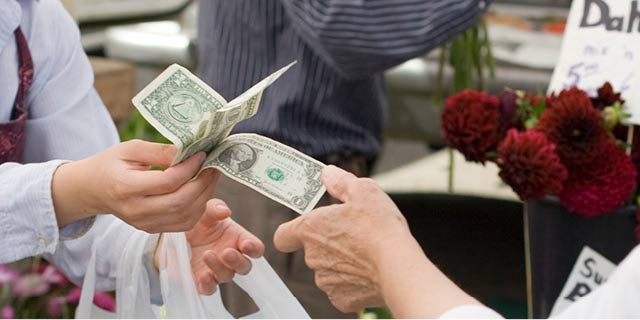
G - TMOZ - C&D Pizza Blog - Desktop Banner CTA (1).png

Why Travel Money
- Bahasa Indonesia
- Slovenščina
- Science & Tech
- Russian Kitchen
How to use a Troika card on Moscow’s Metro, and other ways to buy tickets
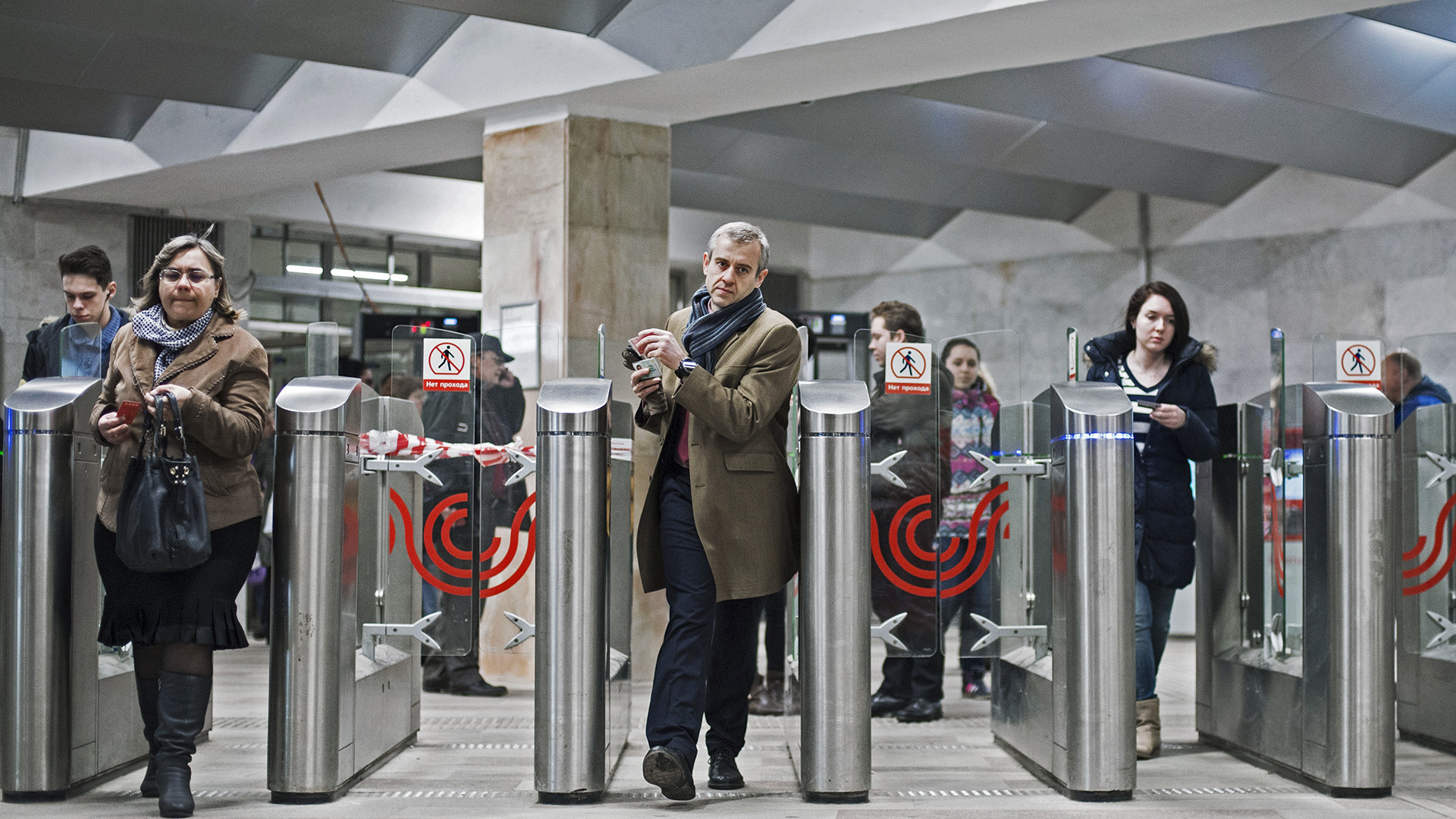
Passengers pass turnstiles at the Serpukhovskaya station of the Serpukhovsko-Timiryazevskaya Moscow metro line.
Moscow residents can now top up their Troika transport cards with the official Moscow Metro app, subway representatives announced on Oct. 31. To put money on the card, passengers simply need to download the app and transfer money via NFC connection. What other ways can you pay for riding on Moscow’s public transport?
Troika card
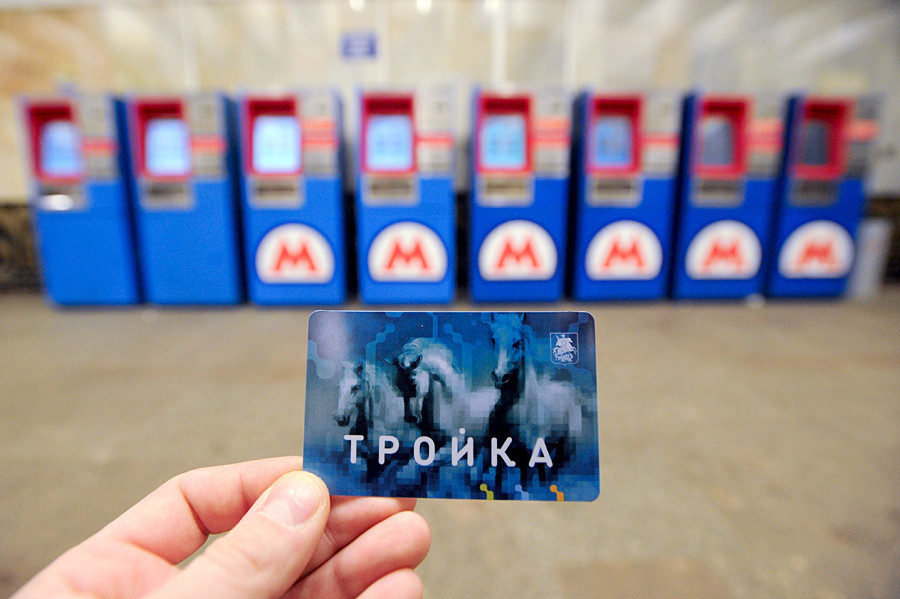
It’s by far the most convenient option for using public transport in the Russian capital. This plastic card is valid for five years, so you don’t need to throw it away after your trip to Russia. You can ride with a Troika on the Moscow metro, as well as Moscow’s Central Ring, buses, trams, and trolley buses.
One ride costs 35 rubles ($0.6), but if you change transport within 90 minutes you will only pay 19 rubles ($0.33) for the next journey. Further changes within those 90 minutes are free.
You can top up your card with the subway attendants who sit behind the glass panels, automated terminals, or via the special Moscow Metro app . Kiosks accept both cash and cards. According to the Moscow Metropolitan official site, you can only keep 3,000 rubles ($51) on your Troika. If you don’t use up all your credit before you leave Moscow, you can cash in the card and get your money back - but this is only possible to do at Metro Service Centers (Ulitsa 1905 Goda street, 25 or Staraya Basmanaya Street, 20 bld 1; 8 a.m.-8 p.m. daily).
Your Troika’s balance can be checked on the app or on the small yellow terminals inside the metro stations.
Important point – one card should only be used by one person (the subway’s rules state that every person should have their own ticket). You can also be hit with a fine of 1,000 ($17) if caught riding the underground without a ticket.
How to get a Troika: Get the card in any metro kiosk or automated ticket office. The card is free, but you need to leave 50 rubles ($0.85) as a deposit. You can return it after.
United (Yediny) ticket
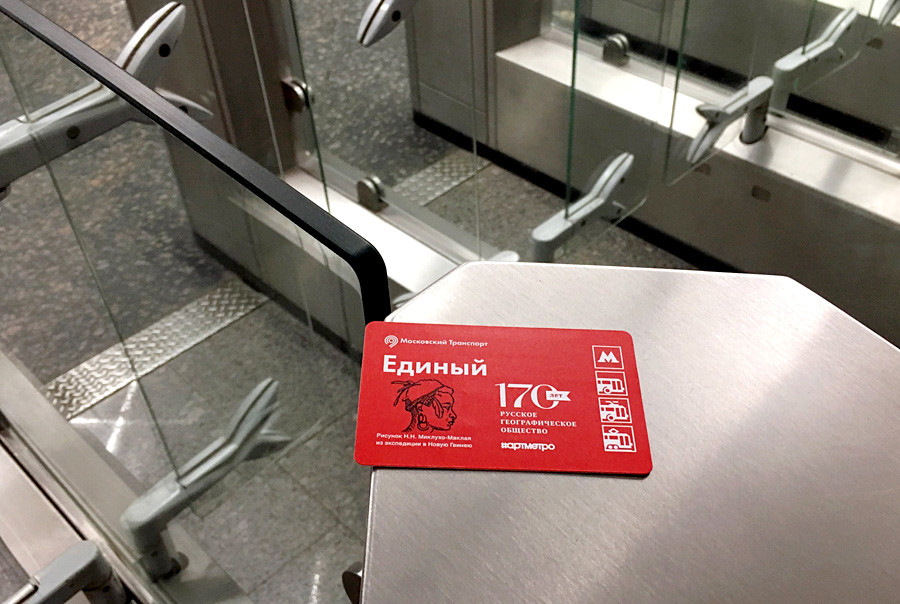
This red paper card can have 1, 2, 20, 40, or 60 rides on any kind of Moscow public transport, and the price depends on the number of rides (more rides you buy the less you pay for a ride), from 55 rubles ($0.95) to 28 rubles ($0.48). If you plan to use transport a lot, you can buy a ticket for 60 rides for 1,700 rubles ($30). A ticket for one or two rides is only valid for five days, while other kind of tickets can be used for 90 days.
If you don’t plan to use metro, you can order a card for ground transport only (it will be dark blue with TAT letters on the cover). This card costs 1,150 rubles ($19) for 60 rides.
How to get it: You can buy this card in any metro kiosk. Cards for one or two rides can be also purchased in automated ticket offices.
Daily tickets
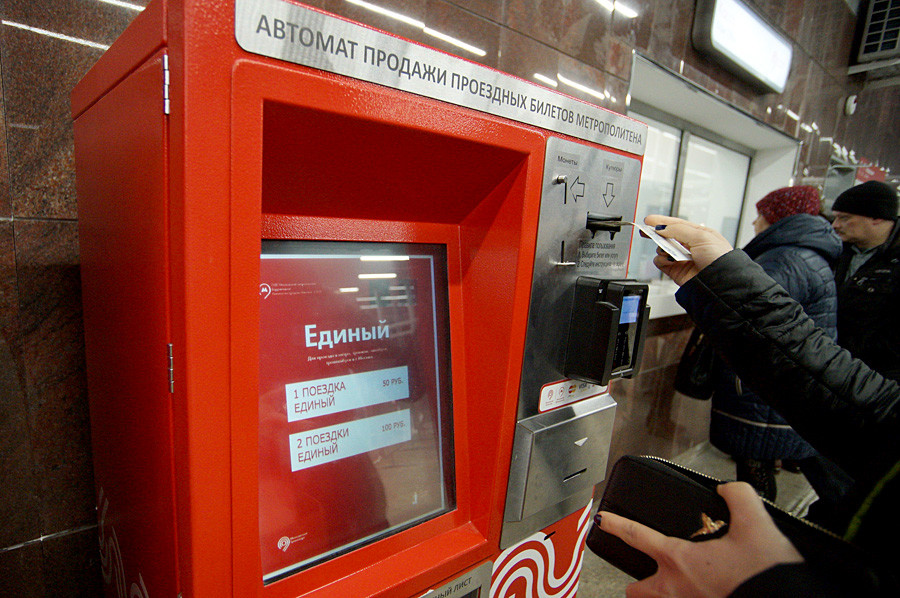
Muscovites often buy tickets without ride limits for specific periods – 30 days, 60 days, or one year. But Moscow Metro suggest special tickets for tourists – for one day (210 rubles, or $3.6), three days (400 rubles, $6.9) or seven days (800 rubles, $13.8). They also can be used on any kind of public transport. Tourists’ tickets also have no limit for rides.
How to get it: You can buy this card in any metro kiosk.
90 minute ticket
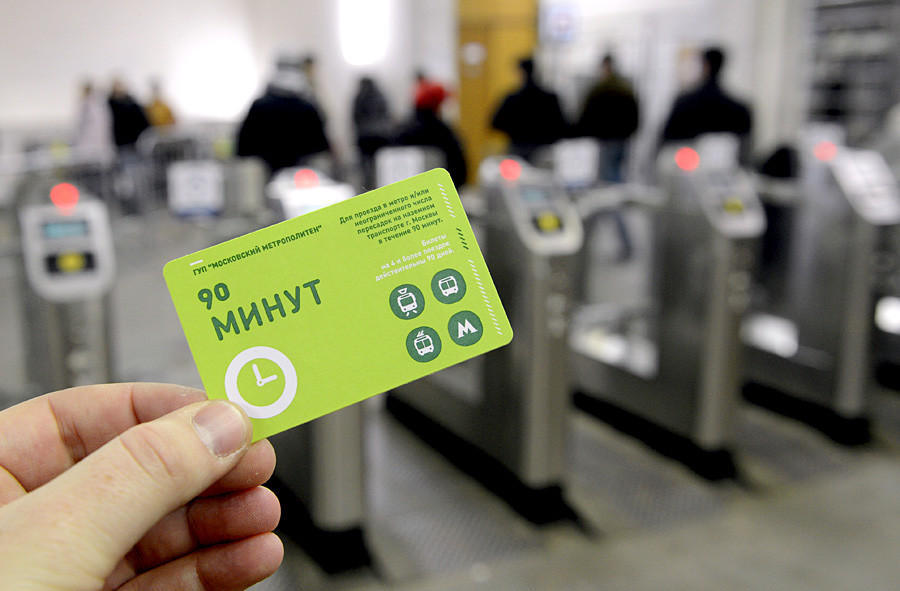
Another kind of ticket allows one ride on the metro and any number of rides on other Moscow public transport within 90 minutes. The card can be for one (65 rubles, or $1.1), two ($130 rubles, or $2.2), and 60 rides (2,650 rubles, or $46). This card is useful if you have to catch different kinds of transport for a short time.
It’s helpful to add this card to your Troika. Moreover, it will save the paper.
Payment via smartphones
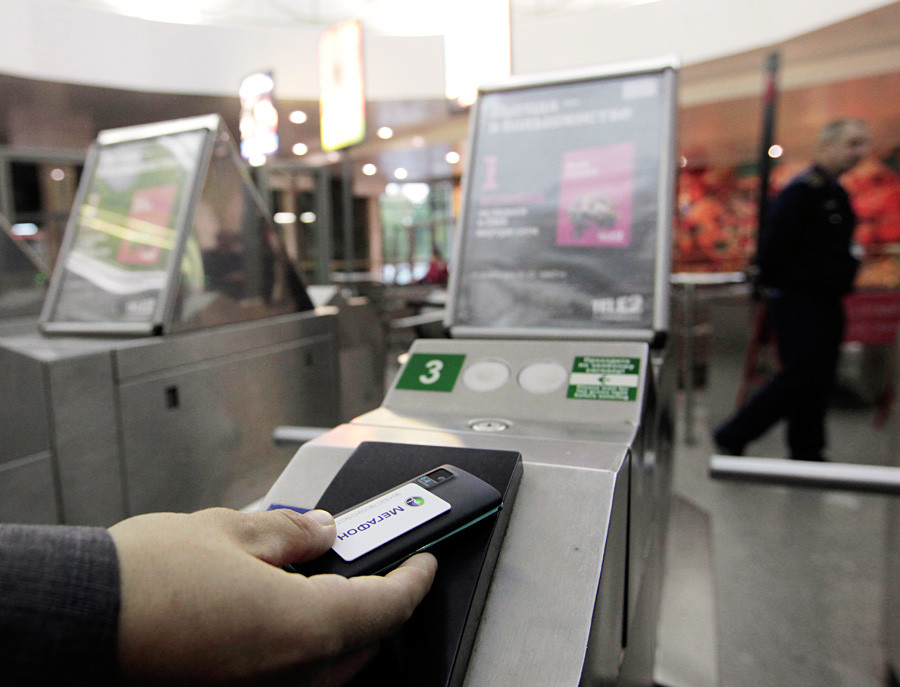
Smartphone owners can pay travel fares via Samsung Pay and Apple Pay, linked with MasterCard credit card and the Wallet app. Apple Pay can also be installed on iWatch. The price for one fare costs 40 rubles ($0.7). You can also use these apps for buying usual tickets in kiosks.
Since late 2016, this system has been available at all ring railway stations and 80 metro stations across the city.
In the future, smartphone-enabled ticket turnstiles will be installed at all Moscow metro stations.
How to get it: Download the Samsung Pay and Apple Pay and start riding!
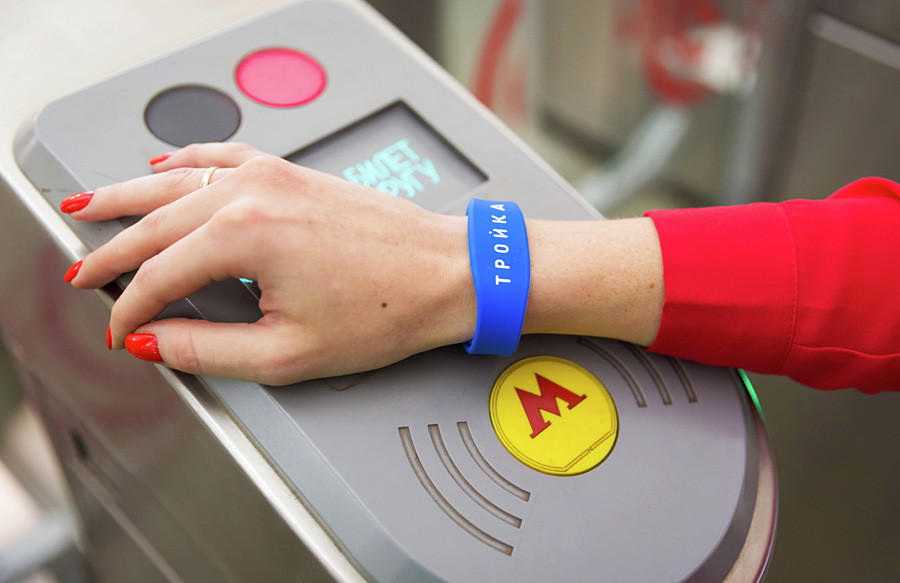
Unique tickets have recently appeared in Moscow. Bracelets, rings, and keychains with transport microchips are not only a souvenir from the Russian capital, but also a serious way to use metropolitan. The deposit price for a bracelet is 450 rubles ($8), for a keychain – 350 rubles ($6). One ring costs 2,200 rubles ($38). The price for a fare is the same as for the Troika card.
How to get it: Only at the Pushkinskaya metro station souvenir kiosk and souvenir shops in the Mayakovskaya and Trubnaya metro stations.
Actually there are other options to inserts transport microchip – for example, in 2015 Moscow engineer Vlad Zaitsev implanted a chip in his hand, so all he has to do is wave at the turnstile and he’s away - but we recommend enjoying Moscow’s transport in a more conventional way.
If using any of Russia Beyond's content, partly or in full, always provide an active hyperlink to the original material.
to our newsletter!
Get the week's best stories straight to your inbox
- Why the new 'Moscow' metro train is being called the best
- Smart Moscow: How technology transforms urban living
- How Moscow's metro grew in 82 years
- How to meet a girl on the Moscow Metro?
- Treasures of the Moscow Metro: Hidden gems of the Purple Line stations
This website uses cookies. Click here to find out more.
- Investing & super
- Institutional
- CommBank Yello
- NetBank log on
- CommBiz log on
- CommSec log on
Help & support
Popular searches
Travel insurance
Foreign exchange calculator
Discharge/ Refinance authority form
Activate a CommBank card
Cardless cash
Interest rates & fees

Travel Money Card: How to manage multiple currencies
If your holiday is looking more like a round the world tour, then you’re going to want to look at loading multiple currencies on to your Travel Money Card.
A Travel Money Card lets you lock in exchange rates for multiple currencies onto one card, so you can easily manage and access your money while you’re overseas.
Related articles

How does a Travel Money Card work?
If you’re in a country that uses a currency you’ve already loaded on your card, that currency will automatically be used for any purchases or withdrawals you make with your card.
If you’re in Europe, for example, and you have Euros, United States Dollars and New Zealand Dollars loaded on your Travel Money Card, your Euros will automatically be used as the local currency, provided you have enough in that currency for your transaction.
If you don’t have enough, the next currency in your currency order with a sufficient balance will be used. For example:
You have 20 Euros (EUR) and 100 New Zealand Dollars (NZD) left on your Travel Money Card and are paying for a meal costing 30 EUR. Since you have insufficient EUR for the full transaction, but sufficient funds in NZD, your Travel Money Card will automatically convert NZD into the equivalent of 30 EUR to pay for your meal (leaving the original 20 Euros on your card), instead of declining the transaction.
With our Travel Money Card , you can easily load up to 13 currencies online:
- United States Dollars (USD)
- Euros (EUR)
- Great British pounds (GBP)
- Australian Dollars (AUD)
- Japanese Yen (JPY)
- New Zealand Dollars (NZD)
- Hong Kong Dollars (HKD)
- Canadian Dollars (CAD)
- Singapore Dollars (SGD)
- Thai Baht (THB)
- Vietnamese Dong (VND)
- Chinese Renminbi (CNY)
- Emirati Dirham (AED)
If we need to automatically transfer money between the currencies on your card to complete a transaction, we'll use the Visa exchange rate at the time of conversion, plus a margin. The margin is subject to change from time to time. For the current margin, see Travel Money Card fees and charges .
To avoid additional fees, always make sure your card is topped up with the local currency by reloading in NetBank or the CommBank app.
Set the currency order on your card
If you have multiple currencies loaded on your card, even though the local currency for where the transaction takes place will automatically be used (assuming you have the currency loaded on your card and sufficient local funds), you may want to set your own order for the currencies loaded on your card. This is especially important if you reload your card via BPAY ® , because the funds will automatically go to the first currency in order.
This is the default currency order which you can change:
To find out more about setting the order of currencies on your card, or to change your current order, log on to NetBank or call (+61) 1300 660 700.
What to do in an emergency
- Lock, Block, Limit your CommBank credit card or lock your Travel Money Card for added security
- Cancel and order replacement CommBank cards in NetBank or the CommBank app
- Call us 24/7 on +61 2 9999 3283 to report lost or stolen CommBank cards
For 24-hour travel insurance emergency assistance, call Cover-More in Australia direct and toll free on +61 2 8907 5641. You can also call from:
- Canada on 1844 345 1662
- New Zealand on 0800 632 031
- UK on 0808 234 3737
- USA on 1844 345 1662
Charges apply if calling from a pay phone or a mobile phone.
Take your next step
Order a Travel Money Card online
Things you should know
This article is intended to provide general information of an educational nature only. It does not have regard to the financial situation or needs of any reader and must not be relied upon as financial product advice. Insurance issued and managed by Cover-More Insurance Services Pty Ltd (AFSL 241713, ABN 95 003 114 145) on behalf of the insurer Zurich Australian Insurance Limited (AFSL 232507, ABN 13 000 296 640) for Commonwealth Bank of Australia (‘CBA’) (ABN 48 123 123 124, AFSL 234945). CBA and its related bodies corporate do not issue or guarantee this insurance. It does not represent a deposit with or liability of either CBA or any of its related bodies corporate. Terms, conditions, exclusions, (including for pre-existing medical conditions and persons aged 80 years or over for international travel insurance included with an eligible CommBank credit card or persons aged 74 years or over for CBA Travel Insurance) limits and excesses apply. Before making a decision, refer to the relevant Product Disclosure Statement for full conditions at commbank.com.au. You need to activate your international travel insurance included with eligible CommBank credit cards before each trip in order to have comprehensive level of cover. If you don’t activate, you’ll receive personal liability cover and overseas emergency medical assistance and overseas emergency medical and hospital expenses cover only. We (CBA) do not provide any advice on this insurance based on any consideration of your objectives, financial situation or needs. If you purchase or upgrade a policy, we (CBA) receive a commission which is a percentage of your premium.

How do I exchange money in Moscow?

You have just arrived in Moscow, maybe even for the first time in Russia and want to get some cash first. It is known that the Russian ruble is used to pay in Russia, and even if card payments are becoming increasingly popular in the giant empire, one cannot do without a little cash in Russia. There are several ways to get rubles and we list the most important ones with all their advantages and disadvantages. In any case, you should first look at the current exchange rate online in order to be able to assess whether you are getting a good exchange rate.
Exchange dollars for rubles at home
If you want to be on the safe side and want to stock up on rubles before you travel to Russia, for example, so that you don’t have to look for an exchange office at the airport, you can do so here. However, this is associated with some effort and usually you get a worse exchange rate.
Larger bank branches in Asia and Australia in mostly have the most common foreign currencies and offer them to their customers for exchange. However, with the increasing acceptance of cards abroad, banks are slowly but surely trying to get rid of this less lucrative business, which is associated with a lot of effort. Exchange rates are becoming increasingly unattractive for customers, and currencies such as the ruble, which are often exchanged less frequently, have to be ordered days in advance.
Stocking yourself up at least with a smaller sum, for example to be able to pay for a taxi at the airport or the train, can make sense. However, you should definitely contact your own bank with sufficient advance notice. The travel bank can receive rubles at branches without any prior contact. These are available at many larger train stations and airports. However, you have to expect to lose about 10-15% of the value.

Exchange at the airport in Russia
The three major Moscow airports Scheremetyevo, Domodedovo and Vnukovo have several exchange offices in all terminals, which are not difficult to find. Exchanging your dollars for rubles is not a problem here. However, you get the worst exchange rates at the airports on average. You lose up to 25% if you exchange dollars for rubles here, that’s why you should definitely avoid this method. Since you can get to the city without cash with card payments both via the Airport Express and a taxi app , you can avoid exchanging money at the airport.
Even with a normal International card (Maestro) you can withdraw money from any ATM in Russia. The fee is usually around 6 $ and you get the actual exchange rate – given the poor exchange rates at the airport, you would save money as of 30 $ that you withdraw.
Exchange at a bank
The large Russian banks such as VTB, Sberbank, Alfa Bank or Bank of Moscow offer currency exchange in almost all branches. The exchange rates are decent and you lose less money than if you exchange at the airport, for example. The advantage of this option is transparency. The banks are all serious and do not try to rip customers off with hidden fees. In addition, the branch network is very dense and you can find bank branches at almost every corner.
Alexander Popov
Welcome to Russia! My name is Alexander, I was born in Moscow and I'm a passionate tour guide. I want to share my passion for Russia and my hometown with you. On my website you will find useful information to make your individual trip to Russia as interesting as possible.
Eating out in Moscow
E visa russia, you will also like, everything you need to know about russia: included..., traveling in russia – how safe it is..., choosing the best guide for a free and..., the best time to travel to russia, how do i get from moscow airports to..., the best taxi services in moscow, moscow’s best free city tour, moscow’s top 13 – the main attractions of..., with sim card purchase in russia: use whatsapp,..., leave a comment cancel reply.
Save my name, email, and website in this browser for the next time I comment.
@2019-2020 - Moscow Voyager. Alexander Popov
We use cookies to provide you with a better experience. By continuing to use our site you accept our cookie policy. Accept Read More

COMMENTS
CommBank Travel Money Card is a convenient, simple and safe way to access your money when travelling overseas. ... (PDF) issued by Commonwealth Bank of Australia ABN 48 123 123 124 for Travel Money Card should be considered before making any decision about this product.
There are 3 ways to load currency on to your Travel Money Card: NetBank & the CommBank app: Transfer money from your eligible CommBank account to your card in NetBank or the CommBank app. Using BPAY: Enter the Biller Code 113167 then your customer reference number (your 16-digit Travel Money Card number). The money may take two to three working ...
The CommBank Travel Money Card is a prepaid Visa card that lets you load up to 13 foreign currencies and lock in exchange rates. You can manage your account online, save on loading fees and enjoy ...
CommBank Travel Money Card (Visa) As NAB and ANZ have closed their travel money cards, this is the only other travel money card available from a major bank. This card has the largest variety of currencies that can be preloaded. Currencies: AUD, USD, NZD, EUR, GBP, SGD, THB, JPY, HKD, CAD, AED, VND, CNY. Fees:
Commonwealth Travel Card Review - [2023] The Commonwealth Travel Money Card is a prepaid Visa debit card you can top up in 13 different currencies, for global spending and ATM withdrawals. That can be handy for managing your budget when you're overseas, as you can lock in exchange rates in advance so you know exactly what you have to spend.
Wise Travel Money Card. AUD,USD,CAD,EUR,GBP,JPY,NZD,SGD. 2 free ATM withdrawals per month up to AUD$350, then AUD$1.50 and 1.75% per withdrawal. $0. $0. Hold and spend funds in more than 40 ...
A Centrally Billed Account, or CBA, is a variation of the government travel charge card used for the Department's specific needs and may be the method of payment for expenses incident to official travel, to include local travel for travelers who do not possess an Individually Billed Account (IBA). There are two main types of CBAs: Transportation and Unit Accounts.
However, how they work is a bit different. The Wise card has a one time order fee of 10 AUD, with 40+ supported currencies and mid-market exchange rates, while the Commbank card is free to pick up, supports 13 currencies, and has rates set by Commbank, including a 3% fee to spend a currency you don't hold. Read on to learn more, and pick ...
Sun. 8:00 am - 6:00 pm. [email protected]. 1800 805 605. ABN: 48123123124. Commonwealth Bank Travel Money Card (Travel Money or Currency Exchange): 1.8 out of 5 stars from 309 genuine reviews on Australia's largest opinion site ProductReview.com.au.
Travel money cards are a popular, convenient and secure way to buy foreign currency and take it overseas. Essentially, travel money cards are specially designed debit cards that you load up with foreign currencies prior to travelling. The advantage of pre-loading the card with your choice of currency is that you can do so when the exchange rate ...
UK - 0800 056 0572. USA/Canada - 1877 465 0085. Japan - 00531 780 221. Thailand - 001800 442 212. New Zealand - 0800 444 691. Hong Kong - 800 966 321. South Korea - 00798 4434 1279. Other countries - +44 207 649 9404. We've compiled this list of the most Frequently Asked Questions from customers about our prepaid travel card.
Manage your card using the CommBank app, NetBank or by calling the Travel Money Card Customer Service Centre which is open 24/7. Online you can Manage your card from anywhere in the world through the CommBank app or NetBank with the option to: • Transfer existing card balances into Check your current balance and transaction history.
Use our currency calculator to work out how much you need in cash, or loaded on one of our travel money cards, for your overseas trip. When you're ready, order online or head to any of our 130+ stores Australia wide. Quick Contact . Call us. instant response. 1300 426 997 . Visit us. for a face-to-face chat ...
The card can be for one (65 rubles, or $1.1), two ($130 rubles, or $2.2), and 60 rides (2,650 rubles, or $46). This card is useful if you have to catch different kinds of transport for a short time.
With our Travel Money Card, you can easily load up to 13 currencies online: If we need to automatically transfer money between the currencies on your card to complete a transaction, we'll use the Visa exchange rate at the time of conversion, plus a margin. The margin is subject to change from time to time. For the current margin, see Travel ...
Since you can get to the city without cash with card payments both via the Airport Express and a taxi app, you can avoid exchanging money at the airport. Even with a normal International card (Maestro) you can withdraw money from any ATM in Russia. The fee is usually around 6 $ and you get the actual exchange rate - given the poor exchange ...